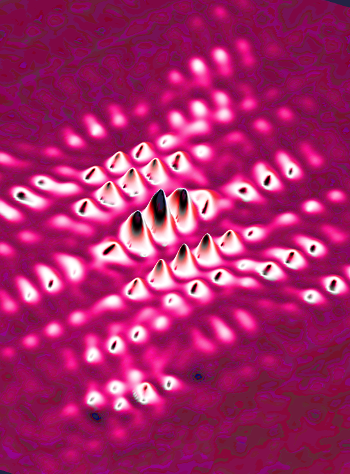Artificial atoms for quantum balance
 Quantum engineers have created artificial atoms to improve the stability of quantum computing.
Quantum engineers have created artificial atoms to improve the stability of quantum computing.
In a paper published today in Nature Communications, UNSW researchers describe how they created artificial atoms in a silicon ‘quantum dot’, a tiny space in a quantum circuit where electrons are used as qubits (or quantum bits) - the basic units of quantum information.
Scientia Professor Andrew Dzurak explains that unlike a real atom, an artificial atom has no nucleus, but it still has shells of electrons whizzing around the centre of the device, rather than around the atom’s nucleus
“The idea of creating artificial atoms using electrons is not new, in fact it was first proposed theoretically in the 1930s and then experimentally demonstrated in the 1990s – although not in silicon. We first made a rudimentary version of it in silicon back in 2013,” says Professor Dzurak.
“But what really excites us about our latest research is that artificial atoms with a higher number of electrons turn out to be much more robust qubits than previously thought possible, meaning they can be reliably used for calculations in quantum computers.
“This is significant because qubits based on just one electron can be very unreliable.”
A quick glance at a periodic table of elements will show that as each atom gets heavier, with more and more electrons, they organise into different levels of orbit, known as ‘shells’.
“It turns out that when we create artificial atoms in our quantum circuits, they also have well organised and predictable shells of electrons, just like natural atoms in the periodic table do,” Professor Dzurak said.
The UNSW team was able to configure a quantum device in silicon to test the stability of electrons in artificial atoms.
They applied a voltage to the silicon via a metal surface ‘gate’ electrode to attract spare electrons from the silicon to form the quantum dot, an infinitesimally small space of only around 10 nanometres in diameter.
“As we slowly increased the voltage, we would draw in new electrons, one after another, to form an artificial atom in our quantum dot,” says Dr Andre Saraiva, who led the theoretical analysis of the results.
“In a real atom, you have a positive charge in the middle, being the nucleus, and then the negatively charged electrons are held around it in three dimensional orbits.
“In our case, rather than the positive nucleus, the positive charge comes from the gate electrode which is separated from the silicon by an insulating barrier of silicon oxide, and then the electrons are suspended underneath it, each orbiting around the centre of the quantum dot. But rather than forming a sphere, they are arranged flat, in a disc.”
The researchers were interested in what happened when an extra electron began to populate a new outer shell.
Currently, imperfections in silicon devices at the atomic level have disrupted the way qubits behave, leading to unreliable operation and errors.
But it seems that the extra electrons in the inner shells act like a ‘primer’ on the imperfect surface of the quantum dot, smoothing things out and giving stability to the electron in the outer shell.
Achieving stability and control of electrons is a crucial step towards silicon-based quantum computers becoming a reality.
It is the spin of an electron that we use to encode the value of the qubit, explains Professor Dzurak.
“Spin is a quantum mechanical property. An electron acts like a tiny magnet and depending on which way it spins its north pole can either point up or down, corresponding to a 1 or a 0,” he said.
“When the electrons in either a real atom or our artificial atoms form a complete shell, they align their poles in opposite directions so that the total spin of the system is zero, making them useless as a qubit. But when we add one more electron to start a new shell, this extra electron has a spin that we can now use as a qubit again.
“Our new work shows that we can control the spin of electrons in the outer shells of these artificial atoms to give us reliable and stable qubits. This is really important because it means we can now work with much less fragile qubits. One electron is a very fragile thing. However an artificial atom with 5 electrons, or 13 electrons, is much more robust.”
More information on the latest experiments is accessible here.







 Print
Print